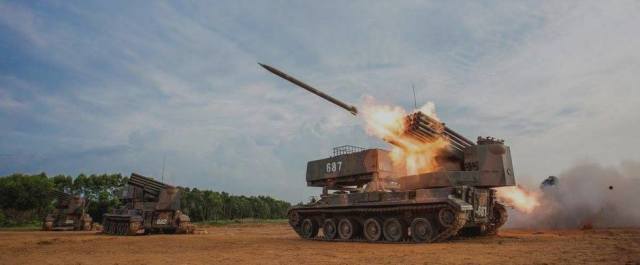In 1969, during the border conflict over the island of Damansky, the Soviet side very successfully used the new BM-21 Grad MLRS. The Chinese military was very impressed with the power of the new weapon. When a captured BM-21 fell into their hands ten years later, they immediately copied it and began to improve it in stages.
The beginning of the development of Chinese jet weapons dates back to the 50s. Based on the design of the Soviet 140-mm projectile, the Chinese created their own reduced versions of rocket projectiles of the caliber 107 and 130 mm, stabilized by rotation. Such MLRS were exported en masse, and a number of countries established their own production. By the early 70s, the tactical and technical characteristics of the 107 and 130 mm caliber systems had already ceased to meet the requirements of the time, but the Chinese specialists clearly lacked their own experience and knowledge to create a new MLRS. I had to look for a" source of inspiration " on the side.
First-generation clones
The conflict over the island of Damansky in 1969 was the combat debut of the new Soviet BM-21 MLRS. The Chinese troops fully felt the firepower of the Grads. However, unlike another Soviet novelty-the T-62 tank-it was not possible to" touch " the BM-21 at that time. The case presented itself only ten years later, when during the war with another socialist neighbor — Vietnam — the Chinese managed to capture a serviceable "Grad", and even with ammunition. As a result, already in 1981, the People's Liberation Army of China (PLA) received the Type 81 MLRS (aka PHL-81)-a copy of the BM — 21 artillery unit, but on the chassis of the CQ260 Hanyang truck (the French Berlier GBU-15, produced in China under license). Later, a variant of this MLRS appeared on the chassis of the Shanxi SX2150 car. In addition to the actual launcher (PU), a transport-loading machine was created. It takes about eight minutes to recharge the PU with it. China has also launched its own 122-mm rocket shells — high-explosive, smoke, cluster (with cumulative fragmentation submunitions) and, probably, chemical ones.

MLRS " type 81»
Image source: flickr.com
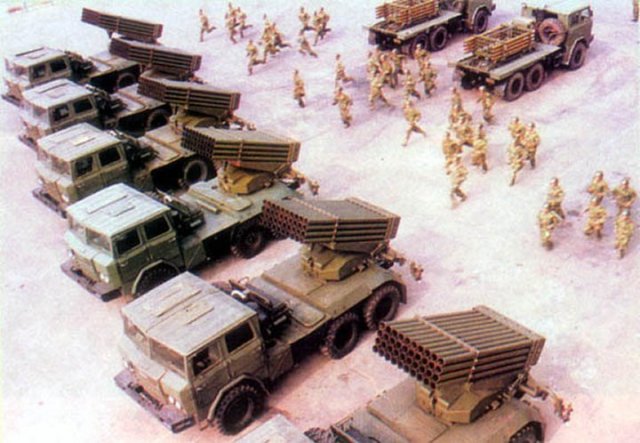
MLRS battery "type 81". In the background — transport-loading machines
Image source: fas.org
A kind of side branch of the development of Chinese grads was the "type 83" system — a 24-barrel launcher on the chassis of the three-axle car "Dong Feng" EQ240, somewhat reminiscent of the" Ural-375", but with a long two-row cabin. In the PLA, it is considered a means of engineering weapons, and not an artillery system, since its main purpose is remote mining of the area with the help of rocket shells equipped with anti-personnel and anti-tank mines. The range of such projectiles is 15 km, but if necessary, the Type 84 can also fire conventional 122-mm rockets with a range of 20 km.
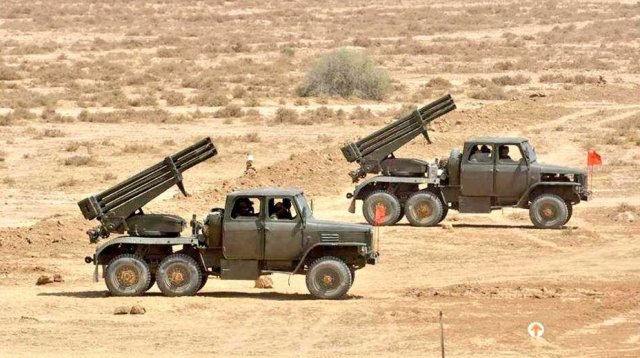
Remote mining system " type 83»
Image source: defence.pk
On a tracked chassis
The further development of the Chinese Grad had two goals: to increase the tactical mobility of the MLRS and to provide the possibility of transporting additional ammunition on the launcher (a solution "peeped" from the Czechoslovak RM-70 MLRS and the Yugoslav M-77 Ogan). These goals were achieved by creating the Type 89 MLRS (PHZ-89). It was possible to increase the cross-country ability by using the WZ-321 tracked chassis from the Chinese Acacia-type 83 self-propelled gun (PLZ-83). In its aft part, a package of guides was placed, and in front of it — a second set of rockets, covered with a lightly armored casing. Thanks to this solution, the reload time of the PU was reduced to three minutes. Another important innovation was the digital fire control system, which provides data transmission via radio link from the command vehicle to the launchers.
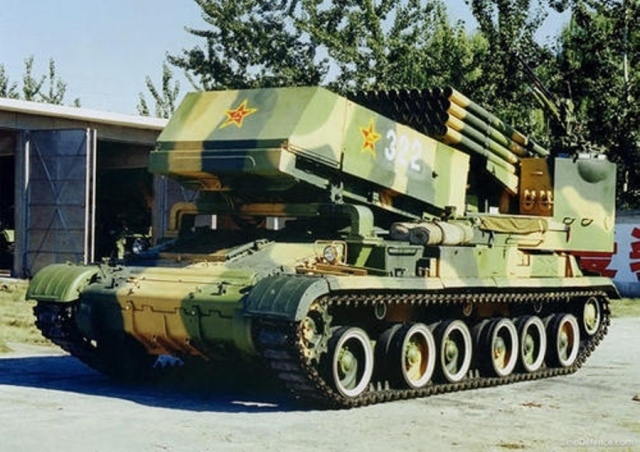
MLRS "type 89" - view from the port side
Image source: tanks-encyclopedia.com
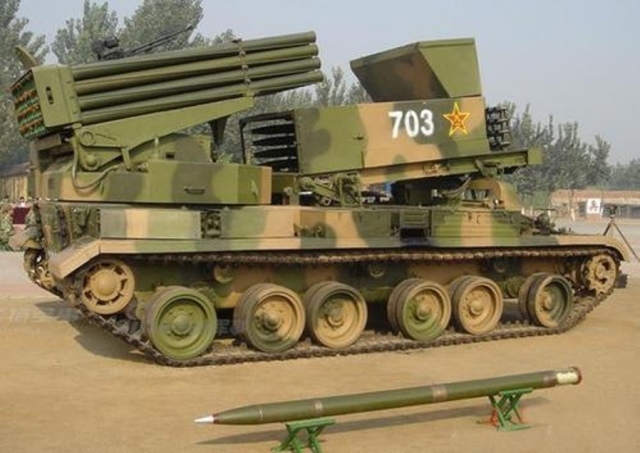
Type 89 MLRS-starboard view
Image source: tanks-encyclopedia.com
The guide pack is located on a pivoting base, and to the left of it, on the same base, is an armored gunner's conning tower. A 12.7 mm machine gun is mounted above its hatch. The combat vehicle is equipped with a filter-ventilation system, so it can operate in conditions of the use of weapons of mass destruction. The PHZ-89 has a WR-4B liquid-cooled diesel engine (a copy of the Deutz 12150L) with a capacity of 520 hp.
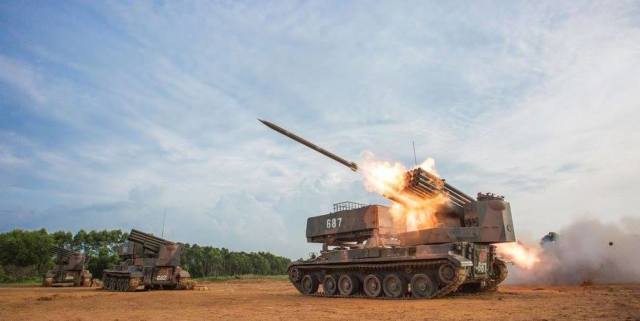
MLRS salvo " type 89»
Image source: chinamil.com.cn
The designation "type 89" seems to hint that the MLRS was adopted in 1989. But with Chinese weapons systems, it often happens that several years pass between the adoption of weapons and the start of deliveries to the troops. In more or less noticeable numbers, the "type 89" went to the troops only in the late 90s. At about the same time, new rockets with a firing range increased to 30 km appeared in the ammunition of the Chinese Grads.
From a tracked chassis to a wheeled one
The solutions tested on the PHZ-89 were further developed in the Type 90 MLRS (PHL-90), which appeared in the mid-90s. Instead of the expensive and heavy tracked chassis, it returned to the automobile-the company "Bay Ben", which produces cars under the license of "Mercedes-Benz". The first version of the "type 90" uses the chassis of the "Tiema" SC2030, on which it was possible to place both a package of guides and a rack with a second set of rockets. A fire control system similar to that used on the Type 89 is also used.
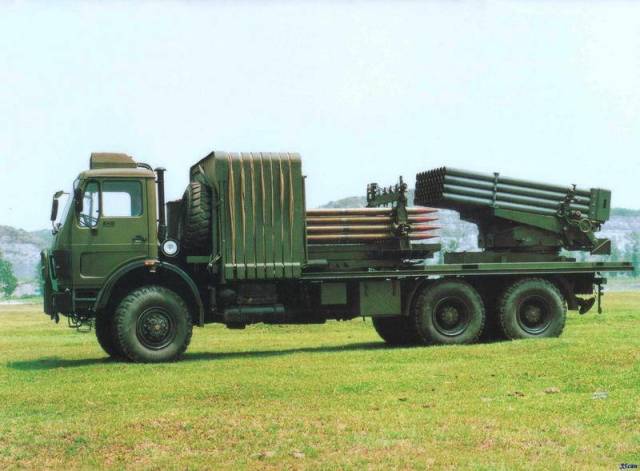
MLRS " type 90»
Image source: fas.org
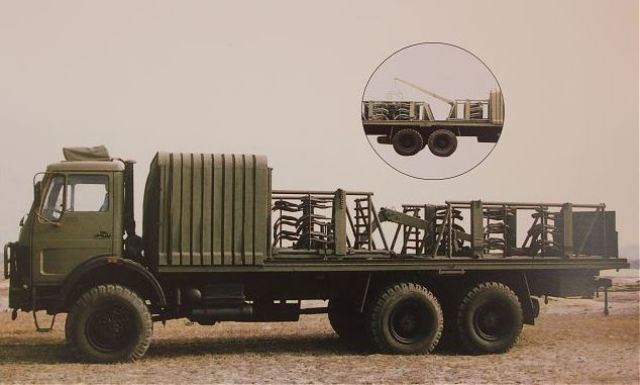
TZM for MLRS " type 90»
Image source: armyrecognition.com
The "Type 90A" variant (PHL-90A) features a more modern "Tiema" XC2200 chassis, as well as an improved control system. Now the guidance of the PU on the target and the salvo were carried out completely in remote mode - on commands from the command and staff vehicle. On the MLRS "type 90B" again changed the chassis (on the "Bay Ben" 2629) and added the ability to use missiles with guidance on the final section of the trajectory.
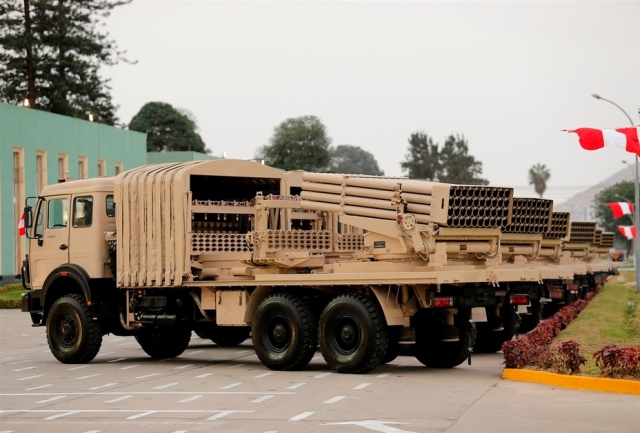
Type 90VM MLRS of the Peruvian Army
Image source: flickr.com
Currently, the PLA has about 550 PHL-81 and PHL-90 MLRS (mainly in the PHL-90A variant), as well as about 375 PHZ-89. Chinese Grads have also found buyers abroad. In particular, the PHL-81 was delivered to Myanmar (20 units), Cambodia (6) and Chad (4). The "Type 90" entered service in the same Myanmar (20), Oman (6), Gabon and Indonesia (4 each). The largest buyer is Peru — the army of this country in early 2014 received 27 advanced systems "type 90VM".
The question of possible supplies of Chinese Grads to the DPRK is very vague. Although this possibility is not discounted, it is still more likely that direct deliveries of original products from the USSR and their further copying by North Korean comrades are considered more likely. Chinese Grads were also not delivered to Pakistan (although such reports sometimes appear) — the Azar MLRS there is a derivative of the North Korean VM-11. The MAM-01 MLRS produced in Myanmar also has North Korean, not Chinese, roots.
New generation
In 2006, at the 6th International Air Show in Zhuhai, a prototype of the PR-50 Shachenbao (Sandstorm) MLRS was presented. In this system, the Chinese designers, while maintaining compatibility in ammunition with the previous Grad clones, finally abandoned the traditional package of BM-21 tubular guides. Instead, two replacement packages-modules containing 25 rockets each-were used. Two additional packs are placed on the combat vehicle, as well as a manipulator arrow for reloading. Compared to the previous versions, the number of shells in the salvo increased by a quarter, and the process of reloading the launcher was significantly simplified. New rockets with a firing range of 45-50 km have been added to the system's ammunition.
Despite all the progressivity of the PR-50 design, there is no information about the receipt of this MLRS into service with the PLA. However, 49 modified systems (with 20-charge module packages instead of 25-charge ones) under the designation WS-22 were exported to Bangladesh in 2014-2015.
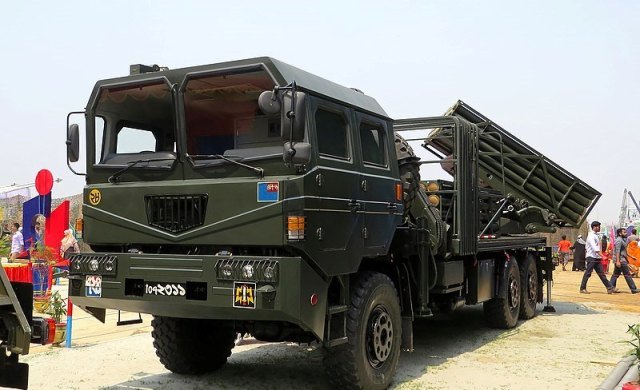
Bangladesh Army WS-22 MLRS
Image source: flickr.com
For its own army, China has developed two new types of 122-mm MLRS that use modular loading, but are based on different chassis. The PHZ-10 (also known as the PHZ-11) has a chassis similar to that used in the PLZ-45, PLZ-52, and PLZ-05 self-propelled guns. In the front part of the PHZ-10 there is an armored "automobile" type cabin, and behind it — a launcher for two 20-charge modules. On the same chassis, a transport-loading machine is produced, equipped with a crane-manipulator. The PHL-11 MLRS has the same artillery unit, but is based on the three — axle all-terrain vehicle "Shanxi" SX2190-a "clone" of the Austrian "Steyr" 91.
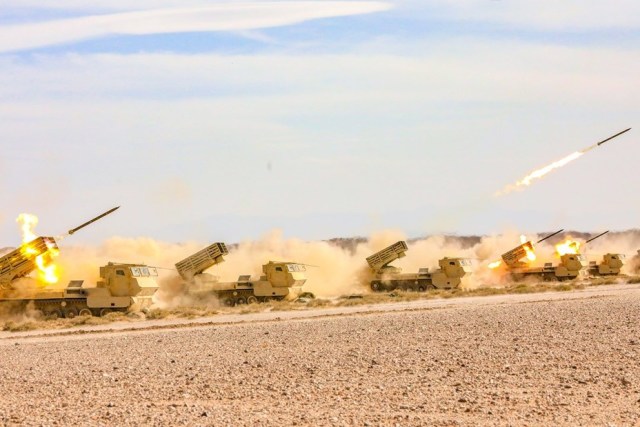
Salvo of the PHZ-10 MLRS battery
Image source: deagel.com
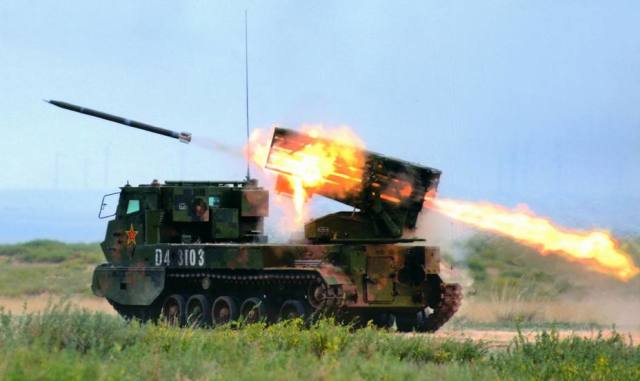
The PHZ-10 MLRS is firing
Image source: imgur.com
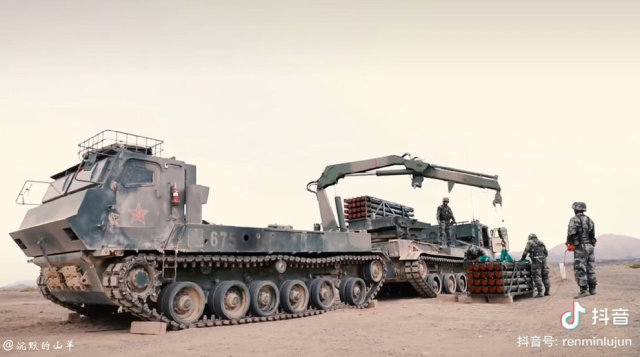
Reloading the PHZ-10 MLRS with TZM
Image source: imgur.com
The new PHL-11 MLRS replace the "Type 81" in medium mixed brigades, and the PHZ-10 replaces the "type 89" in heavy brigades. By the beginning of 2020, the Chinese army received about 350 PHL-11s and about a hundred PHZ-10s. Production of these machines continues. The new 122-mm MLRS still cannot boast of special export success-only the sale of four PHL-11 systems (under the export designation SR4) to Thailand in 2013 is known. In China, further work is underway on the 122-mm MLRS. In particular, the mountain brigades began to receive lightweight systems on the chassis of two-axle all-wheel drive vehicles FAV MV3 CTM133.
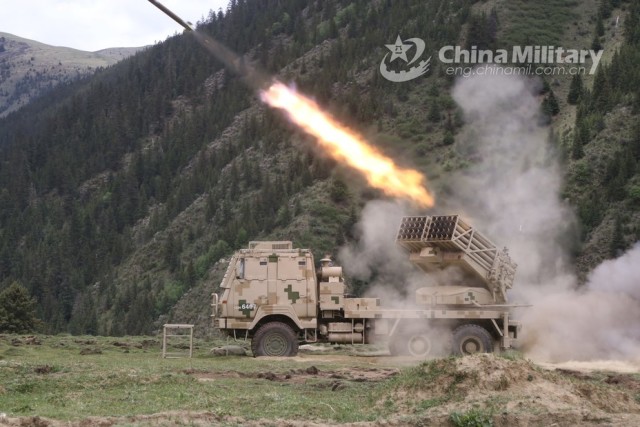
MLRS PHL-11
Image source: chinamil.com.cn
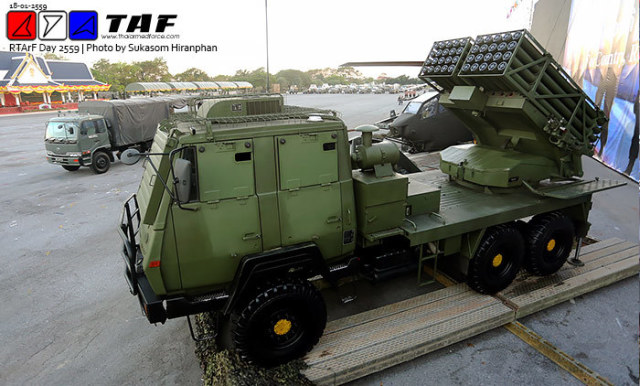
SR4 MLRS of the Thai Army
Image source: thaiarmedforce.com
|
|
PHL-81
|
PHZ-89
|
PHZ-10
|
PHL-11
|
|---|---|---|---|---|
|
Calculation, person
|
6-7
|
4
|
3
|
5
|
|
Combat weight, t
|
15,5
|
29,9
|
20
|
16
|
|
Length, mm
|
7200
|
7180
|
7500
|
8000
|
|
Width, mm
|
2520
|
3150
|
3200
|
2550
|
|
Height, mm
|
3050
|
3180
|
3200
|
3100
|
|
Engine power, hp
|
200
|
520
|
600
|
350
|
|
Highway speed, km / h
|
70
|
55
|
65
|
90
|
|
Power reserve on the highway, km
|
600
|
450
|
500
|
600
|
Sources:
- armyrecognition.com
- chinamil.com.cn
- deagel.com
- defence.pk
- military-today.com
- tanks-encyclopedia.com
Andrey Haruk
